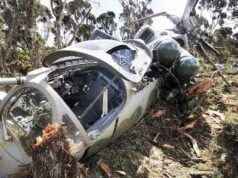 Cuba was for all intents and purposes a whore of the United States of America. Located just 90 miles from the coast of Florida, it was an ideal post for American hard drug barons, sexual perverts, gamblers and a cocktail of all manner of criminal gangs.
Cuba was for all intents and purposes a whore of the United States of America. Located just 90 miles from the coast of Florida, it was an ideal post for American hard drug barons, sexual perverts, gamblers and a cocktail of all manner of criminal gangs.
So brazen was the domination, the exploitation and the humiliation of Cuba that in 1946 the American organized crime staged what they called the ‘Havana Conference’ there. This was a sad turn of events because since the 18th century, Cubans fought hard and bravely against Spanish colonial domination. When independence was finally achieved in 1902, America took over and lined up a succession of experienced fools – committed to their dark motives – to rule Cuba as Presidents.
Then Fidel Castro, the greatest revolutionary leader in the world came. He rode into Havana on the1st January 1959 with his friend and collaborator Che Guavera at the head of their revolutionary army to change the destiny of Cuba. The puppet President, the army sergeant who pretended to be a general, the corrupt and tyrannical Fulgencio Batista who plundered Cuba with American support took to his heels to meet his puppet masters in the US.
Within days of Castro’s assumption of power, Earl T Smith resigned as US Ambassador to Cuba. He later confessed during a testimony to the US Senate in 1960 that “until Castro, the U.S. was so overwhelmingly influential in Cuba that the American ambassador was the second most important man, sometimes even more important than the Cuban president.”
Castro did not hide his ideas of what to do with power in Cuba. In “History Will Absolve Me”, a four-hour speech he made on 16 October 1953 in his own defense in court against the charges brought against him after he led an attack on the Monacada Barracks, he put everything in black and white. Still, his trenchant and frequent denunciation of the US when he came to power, his agrarian reforms and the nationalization of industries owned by US citizens was something of a surprise and increasing concern in Washington. He often openly defied the US and seemingly got away with it.
President Dwight D Eisenhower of the US officially recognized the new Cuban government in 1959 immediately Castro came to power. Castro responded and in April 1959 led a delegation of representatives to the U.S. as guests of the Press Club. Ironically while his performance during the visit charmed the American people, their government was not amused by his reform program which he outlined to Vice President Richard Nixon.
Castro on return to Havana intensified state intervention and take-over of privately owned businesses in Cuba; America increased trade restrictions. It was a game of tit for tat. Each time the Cuban government nationalized American citizens properties, the American government took countermeasures, resulting in the prohibition of all exports to Cuba on 19 October 1960.
Later that year, U.S. diplomats Edwin L. Sweet and William G. Friedman were arrested and expelled from the island having been charged with “encouraging terrorist acts, granting asylum, financing subversive publications and smuggling weapons.” From the economic to the diplomatic front, relations between the two countries were taking a dangerous dive. On 3 January 1961 the U.S. withdrew diplomatic recognition of the Cuban government and closed the embassy in Havana. Cuba on the other hand consolidated trade and diplomatic relations with the USSR.
Military tensions followed. In March 1960 the freighter La Coubre exploded in Cuba and Castro held the US responsible for the terror attack. In 1961 the CIA trained, shipped and landed 1,500 Cuban exiles at the Bay of Pigs with the sole aim of assassinating Fidel Castro and overthrowing his government. But Castro mobilized his people to resist and defeat the invaders. This humiliation did not deter the US from embarking on more desperate moves against Castro and Cuba.
From the ‘Cuban Project’ through ‘Operation Mongoose’ to ‘Operation Northwoods’ and ‘Operation Ortsac’, several anti Castro plans were formulated. A coordinated program of political, psychological, and military sabotage, involving intelligence operations as well as assassination attempts on key political leaders became the guiding principle of US policy to Cuba. There were also to be attacks on mainland U.S. targets, hijackings and assaults on Cuban refugee boats to generate U.S. public support for military action against the Cuban government.
An opportunity to heighten tensions between the two nations came when the US placed nuclear warheads in Turkey, targeted at the USSR. Castro in turn invited the USSR to install its own nuclear war heads in Cuba targeting Washington. This led to the Cuban Missile Crisis of 1962. Even though the missiles were later removed, the US tightened her economic blockade on Cuba which has not been relaxed up till date. Similarly, the US never gave up on its plans to assassinate Fidel Castro. Officially, over 600 attempts were made by the US government on his life before he died of natural causes on November 25 2016.
Against all these odds, Fidel Castro was able to improve the lot of the Cuban poor. In 1953, the poor in Cuba who were 40% of the population shared only 6.5% of the National income. In 1996, they had a share of 26%. Equally impressive is the Cuban educational system after the revolution which has been made free at all levels. This has raised literacy level to 98.1%, the highest in the world. In the mid90s Cuba had 530,000 university graduates, (5% of the population out of which 5000 were doctorates. [myad]








